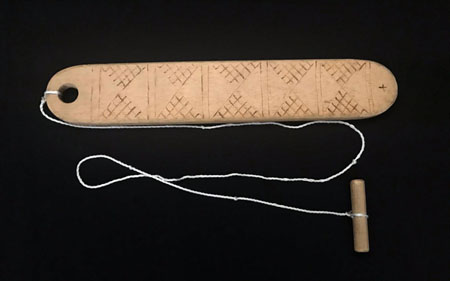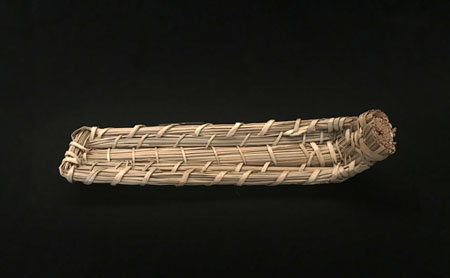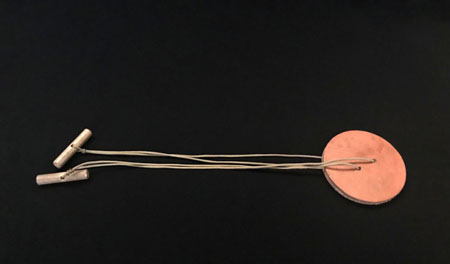Three copies of the Coast Miwok kit are available for checkout. Each kit is one complete unit, adaptable for grades 3 to 8. Included in the kit are integrated lessons outlined in the teacher's guide, images, and artifacts that have been carefully selected to acquaint students with primary sources. Below are some images and labels about some of the artifacts in this kit.
Bull Roarer
The bull roarer or free aerophine, along with rattles, are among the world's oldest instruments. The bull roarer is a wooden slat on a cord and is played by spinning the slat on its cord's axis around one's head. The two motions of rotation and orbit create two pitches making a low fluttering hum accompanied by an eerie throbbing pulse. The local coast Miwok word for the bull roarer was "kiwil-witila-tumai' which translates to wind-turn-stick. One account credits the people from Tomales in northwestern Marin with using the bull roarer in a dance where "they made the stick sing." The bull roarer had ceremonial uses. It was believed that the bull roarer invited thunder, occasionally causing storms. Although the old bull roarers were decorated, we do not know what designs were used. The designs on this bull roarer are based on designs incised on bird bone ear ornaments dating from the 17th century.

Square Stern Tule Boat
The Pomo name for the one-man version of this boat was tsuta xina, meaning one-man boat. This was a Poma name, but this type of tule boat was used by all tribes in the central California area, including the Coast Miwok. The Pomo and related people chose three floor bundles and a fourth gunwale bundle to build this variation of a Piute balsa canoe. It was constructed in progressive lay-ups from the bow to the stern. This boat is the only example of this technique in California. The only other two examples of this type of boat construction are found on Lake Titicaca in Peru and Lake Chad in Africa. The small, one-man version measured seven to eight feet long and was three feet wide. The utility version of this canoe was eighteen to twenty feet long and held from four to five people. The large version was twenty-six to twenty-eight feet long. These boats were very versatile and were used for many things from transporting people and goods to fishing.

Leather Buzzer
This toy is similar to the button on the string, which has delighted children for ages. String was made from native plant materials. Holes were made in the leather with an awl. The string is looped over the first finger on each hand with the leather disc centered in between. The circle of leather is flipped over and over twisting the string. Gently pulling the fingers apart causes the string to wind and unwind and makes the buzzing noise.

